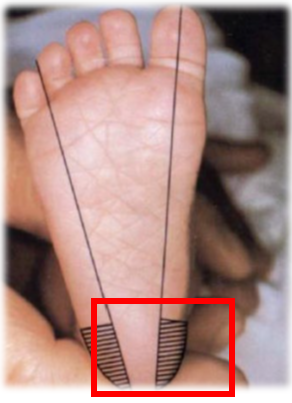Heel Stick Collection Training and Resources
| Heel Stick Quality Training Module: Online training module designed by the GNBS Program to educate newborn heel stick collection staff about heel stick collection best practices. This training will discuss the basics of the newborn heel stick screening, heel stick collection protocol and heel stick quality indicators. |
Neonatal Screening Instruction Handout: Step-by-step instructions for performing the heel stick. |
Simple Spot Check Handout: Visual aid that displays what good quality and poor quality dried blood spots look like. |
CLSI Heel Stick Collection Demonstration Video: Resource from CLSI that shows how to properly perform a newborn heel stick. You will be directed to create a free CLSI account. Once your account is created, you will have 24/7 access to the free video. Click here to preview the video without creating a CLSI account. |
NBS Card Tips Infographic: Visual aid to help birthing facility staff and midwives ensure all fields on the newborn screening card and dried blood spot consent card are completed appropriately. |
Newborn Screening Card Guidelines
Storing and Handling New/Unused Newborn Screening Cards
Store new cards upright, not flat. This helps to keep the fibers within the filter paper from becoming compressed. Compressed fibers lead to uneven saturation and quality issues like uneven saturation.
Store cards in a cool, dry location. This should be away from any direct sunlight or heat.
Do not photocopy the cards. If you need a copy for your own reference, simply detach the yellow carbon copy.
Newborn Screening Card Expiration Date
Every newborn screening card is printed with an expiration date. Always check the expiration date prior to performing the heel stick.
NBS cards can be used for blood spot collection through the last day of the month of the expiration date printed on the card.
Expired cards submitted for screening will be considered unsatisfactory and another screen will be requested, which could delay diagnosis and treatment. It is essential to review newborn screening card expiration dates regularly to help manage inventory.
Filling out the Newborn Screening Card
The submitter is responsible for the accuracy and completeness of the information on the newborn screening card. Please take special care to fill out all fields as accurately as possible.
If the information written on the newborn screening card needs to be updated after the card has already left your facility, complete a NBS Lab Change of Information Form and fax it to the NBS Laboratory at 317-321-2495 as soon as possible.
Best Practice for Heel Stick Collection
- Prep: Warm the heel using an instant chemical heel warmer, or a warm cloth for 3-5 minutes. Sanitize the heel with an alcohol prep pad. Wipe dry with sterile gauze.
- Stick: Ensure baby’s leg is lower than their heart. Use a lancet that is 1.0mm deep by 2.5mm long for healthy infants. Use a smaller lancet for premature or low birthweight babies. Puncture the heel within the shaded area only!
- Drop: Gently touch the filter paper to the blood droplet and allow to saturate on the paper until fully saturated through to the ot
her side. Do not rub or wipe the heel onto the paper. Do not place more blood on top of a circle that already has blood in it.
- Care: Lift the baby's leg above its body. Gently apply pressure against puncture site with sterile gauze to end blood flow. Do not apply a bandage.
- Dry: Lay the blood specimens flat to dry for at least 3 hours. It is best to elevate the card off the surface while drying. Avoid direct sunlight, heat and humidity. Immediately transport the NBS cards to the NBS Lab Courier pick-up location after they have dried for 3 hours. Do not leave NBS cards in drop boxes or mailboxes that are in direct sunlight.
- Check: Always perform a last quality check BEFORE the newborn is discharged home.
